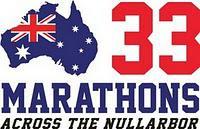 Now the obvious way to improve your times is through running more and better training, but that is not what this post is all about. This is focused on how you can be more efficient in a race to save valuable minutes, even hours.
Now the obvious way to improve your times is through running more and better training, but that is not what this post is all about. This is focused on how you can be more efficient in a race to save valuable minutes, even hours.The most obvious way to reduce your time is to spend less time at checkpoints. This really comes down to good planning an organisation. If you have a support crew make sure they are well briefed and know what needs to be done. I draw up a check list for mine, and make sure that they have everything I need for the next section prepared and ready to go. I have even heard of people having separate packs that they can just swap at the checkpoint and get going. It may seem extravagant, but could save you a heap of time at each CP.
If you are relying on a drop bag you just need to be a little more organised. I include a checklist in mine as often after running for a few hours you may not be as mentally sharp as you would like and forget something. It’s also good to put motivational reminders on these too as a pick me up.
 An important factor to consider at checkpoints and racing in general is to keep weight to a minimum. It may not seem like an extra kilo has much effect, but when compounded over a day long run the impact can be significant. So plan ahead. Know your fluid requirements (dependent on conditions of course) so that you are not carrying more than you need. If the distance to the next CP is going to take you 3-4 hours then are going to want to have a full load, but if it’s only an hour, then perhaps you just need one small bottle to get you through.
An important factor to consider at checkpoints and racing in general is to keep weight to a minimum. It may not seem like an extra kilo has much effect, but when compounded over a day long run the impact can be significant. So plan ahead. Know your fluid requirements (dependent on conditions of course) so that you are not carrying more than you need. If the distance to the next CP is going to take you 3-4 hours then are going to want to have a full load, but if it’s only an hour, then perhaps you just need one small bottle to get you through.On a particularly hot ultra I added an extra bottle of drink to my pack at a checkpoint as it was likely that I would need it. As it turns out I didn’t and then forgot about it, so was carrying the extra weight for the next 80kms!
So your plan (which includes your drop bag notes or crew briefing) should include what you want to be carrying with you as you leave each checkpoint to get you to the next. This also includes an awareness of what is available at each checkpoint, and any mandatory gear requirements. There is no point carrying a torch and spare batteries if you are not going to need them. Basically you want to be finishing each section with as light a pack as possible.
 A good way to minimise the weight you carry is to have a small pack, that way it is not possible to carry anything more than absolutely necessary. The tendency with a large pack is to fill it just because you have the space. (We’ve all packed for a holiday and thrown in an extra pair of shoes or a shirt just because there was space in the case). Nick Wienholt wrote a nice post on his kit list for the recent TNF100 showing his thought processes which paid off with a PR for him.
A good way to minimise the weight you carry is to have a small pack, that way it is not possible to carry anything more than absolutely necessary. The tendency with a large pack is to fill it just because you have the space. (We’ve all packed for a holiday and thrown in an extra pair of shoes or a shirt just because there was space in the case). Nick Wienholt wrote a nice post on his kit list for the recent TNF100 showing his thought processes which paid off with a PR for him.It is inevitable in an ultra that you will need to eat, drink, pee and usually adjust your kit while you are between checkpoints. The most efficient method is to time these when you are traveling more slowly, usually on uphills. The logic is simple if you have to slow or stop for say 30 seconds when running slowly you will lose say 50metres, if you were to do the same on a faster section you could lose 100metres.
Knowing what lies ahead can help you be more efficient so that these interruptions have minimal or no impact on your pace. So doing things such as taking a gel or extra fluid well before a tough effort will ensure that you’re muscles have the extra energy available when you need it rather than waiting until you are feeling tired.
Finally there is one other tip which will no doubt seem strange, but one that I have experienced on a number of occasions. Simply remembering to run! When you have been on a tough section which requires that you walk for any period, it is very easy to get into the walking rhythm, when you’re quite able to run. This has made a massive impact on my personal performance, and again illustrates the psychological side of this sport.
So try adopting these principles and finish your next race with no regrets of what could have been. It could be the difference between taking home a buckle and having your pant’s fall down!
 I haven’t been posting much of late as my available time has been severely reduced as I increase my training for my 33 Marathons challenge in 7 weeks time. The event website is now up and running, so please take a look and pledge your support for the great charities. The Facebook page is also going live this weekend, so you can “like” it here to keep posted on progress, as well as follow us on Twitter:
I haven’t been posting much of late as my available time has been severely reduced as I increase my training for my 33 Marathons challenge in 7 weeks time. The event website is now up and running, so please take a look and pledge your support for the great charities. The Facebook page is also going live this weekend, so you can “like” it here to keep posted on progress, as well as follow us on Twitter:Follow @33Marathons
 Please also like to vote for my nomination in the Vegemite “Toast of a Nation”, any proceeds of which will go towards the event. Thanks for your support :o)
Please also like to vote for my nomination in the Vegemite “Toast of a Nation”, any proceeds of which will go towards the event. Thanks for your support :o)Run Happy
Andy
“Happiness does not come from doing easy work but from the afterglow of satisfaction that comes after the achievement of a difficult task that demanded our best.” – Theodore Rubinwww.ultrarunning.com.au

